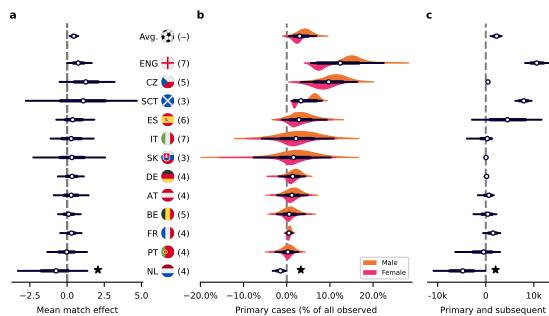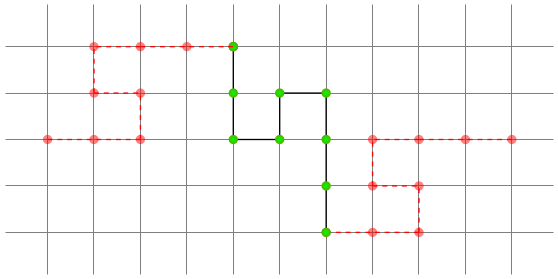About
Hello and welcome! I am a physicist and data scientist with a passion for web development and visualization. My interests in these fields were sparked during my studies, where I learned the power of effective communication through data-driven visualizations. As a data scientist, I have had the opportunity to work on a variety of projects, including Covid-19 research, where I applied Bayesian inference techniques to gain insights into spreading dynamics. Through my work, I have developed a deep appreciation for the importance of clear and engaging communication to help people understand complex information. I am excited to continue exploring the intersection of these fields and applying my skills to solve challenging problems.
My Work
Publications
Here, you can find a comprehensive list of my publications, each one accompanied by a visually appealing graphic and an abstract. In the descriptions, you will also find links to the publications as well as supplementary materials. I take great pride in my work and strive to make my research accessible to anyone who is interested. If you have any questions or would like to learn more about any of my publications, please do not hesitate to contact me.
Impact of the Euro 2020 championship on the spread of COVID-19
Large-scale events like the UEFA Euro 2020 football (soccer) championship offer a unique opportunity to quantify the impact of gatherings on the spread of COVID-19, as the number and dates of matches played by participating countries resembles a randomized study. Using Bayesian modeling and the gender imbalance in COVID-19 data, we attribute 840,000 (95% CI: [0.39M, 1.26M]) COVID-19 cases across 12 countries to the championship.

The impact depends non-linearly on the initial incidence, the reproduction number R, and the number of matches played. The strongest effects are seen in Scotland and England, where as much as 10,000 primary cases per million inhabitants occur from championship-related gatherings. The average match-induced increase in R was 0.46 [0.18, 0.75] on match days, but important matches caused an increase as large as +3. Altogether, our results provide quantitative insights that help judge and mitigate the impact of large-scale events on pandemic spread.
Relaxing restrictions at the pace of vaccination increases freedom and guards against further COVID-19 waves
In this work, we quantify the rate at which non-pharmaceutical interventions can be lifted as COVID-19 vaccination campaigns progress. With the constraint of not exceeding ICU capacity, there exists only a relatively narrow range of plausible scenarios. We selected different scenarios ranging from the immediate release of restrictions to more conservative approaches aiming at low case numbers. In all considered scenarios, the increasing overall immunity (due to vaccination or post-infection) will allow for a steady increase in contacts. However, deaths and total cases (potentially leading to long covid) are only minimized when aiming for low case numbers, and restrictions are lifted at the pace of vaccination. These qualitative results are general. Taking EU countries as quantitative examples, we observe larger differences only in the long-term perspectives, mainly due to varying seroprevalence and vaccine uptake. Thus, the recommendation is to keep case numbers as low as possible to facilitate test-trace-and-isolate programs, reduce mortality and morbidity, and offer better preparedness against emerging variants, potentially escaping immune responses. Keeping moderate preventive measures in place (such as improved hygiene, use of face masks, and moderate contact reduction) is highly recommended will further facilitate control.
A look into the future of the COVID-19 pandemic in Europe: an expert consultation
How will the coronavirus disease 2019 (COVID-19) pandemic develop in the coming months and years? Based on an expert survey, we examine key aspects that are likely to influence COVID-19 in Europe. The future challenges and developments will strongly depend on the progress of national and global vaccination programs, the emergence and spread of variants of concern, and public responses to nonpharmaceutical interventions (NPIs). In the short term, many people are still unvaccinated, VOCs continue to emerge and spread, and mobility and population mixing is expected to increase over the summer. Therefore, policies that lift restrictions too much and too early risk another damaging wave. This challenge remains despite the reduced opportunities for transmission due to vaccination progress and reduced indoor mixing in the summer. In autumn 2021, increased indoor activity might accelerate the spreadagain, but a necessary reintroduction of NPIs might be too slow. The incidence may strongly rise again, possibly filling intensive care units, if vaccination levels are not high enough. A moderate, adaptive level of NPIs will thus remain necessary. These epidemiological aspects are put into perspective with the economic, social, and health-related consequences and thereby provide a holistic perspective on the future of COVID-19.
Towards a long-term control of COVID-19 at low case numbers
As SARS-CoV-2 is becoming endemic, a sustainable strategy to manage the pandemic is needed, especially when facing a steep wave. We identified a metastable regime at low case numbers, where test-trace-and-isolate (TTI) together with moderate contact reduction is sufficient to control the spread.

However, this control is lost once case numbers overwhelm the limited TTI capacity. Beyond that tipping point, increasingly more infectious individuals remain undetected, generating a self-accelerating spread. To reestablish control, a lockdown (circuit breaker) has to strike a delicate balance between duration, stringency, and timeliness; otherwise, lockdowns are ineffective, or their effect is soon lost. However, once reestablishing control at low case numbers, no additional lockdowns are necessary. In the long-term, immunity and large-scale testing will further facilitate the control of COVID-19.
The foreshadow of a second wave: An analysis of current COVID-19 fatalities in Germany
A second wave of SARS-CoV-2 is unfolding in dozens of countries. However, this second wave manifests itself strongly in new reported cases, but less in death counts compared to the first wave. Over the past three months in Germany, the reported cases increased by a factor five or more, whereas the death counts hardly grew. This discrepancy fueled speculations that the rise of reported cases would not reflect a second wave but only wider testing.
We find that this apparent discrepancy can be explained to a large extent by the age structure of the infected, and predict a pronounced increase of death counts in the near future, as the spread once again expands into older age groups. To re-establish control, and to avoid the tipping point when TTI capacity is exceeded, case numbers have to be lowered. Otherwise the control of the spread and the protection of vulnerable people will require more restrictive measures latest when the hospital capacity is reached.
The challenges of containing SARS-CoV-2 via test-trace-and-isolate
Without a cure, vaccine, or proven long-term immunity against SARS-CoV-2, test-trace-and-isolate (TTI) strategies present a promising tool to contain the viral spread. For any TTI strategy, however, a major challenge arises from pre- and asymptomatic transmission as well as TTI-avoiders, which contribute to "hidden", unnoticed infection chains.

In our semi-analytical model, we identified two distinct tipping points between controlled and uncontrolled spreading: one, at which the behavior-driven reproduction number of the hidden infections becomes too large to be compensated by the available TTI capabilities, and one at which the number of new infections starts to exceed the tracing capacity, causing a self-accelerating spread.
We investigated how these tipping points depend on realistic limitations like limited cooperativity, missing contacts, and imperfect isolation, finding that TTI is likely not sufficient to contain the natural spread of SARS-CoV-2. Therefore, complementary measures like reduced physical contacts and improved hygiene probably remain necessary.
Model-based and model-free characterization of epidemic outbreaks
In these technical notes, we provide detailed background information for our work on Bayesian inference of change-points in the spread of SARS-CoV-2 and the effectiveness of non-pharmaceutical interventions (Dehning et al., Science, 2020).

We outline the general background of Bayesian inference and of SIR-like models. We explain the assumptions that underlie model-based estimates of the reproduction number and compare them to the assumptions that underlie model-free estimates, such as used in the Robert-Koch Institute situation reports. We highlight effects that originate from the two estimation approaches, and how they may cause differences in the inferred reproduction number.
Furthermore, we explore the challenges that originate from data availability — such as publication delays and inconsistent testing — and explain their impact on the time-course of inferred case numbers. Along with alternative data sources, this allowed us to cross-check and verify our previous results.
Bachelors thesis: Monte Carlo simulations of periodic self-avoiding walks
The self-avoiding walk is one of the simples basic problems in statistical physics. Nonetheless, few properties can be determined in a rigorous mathematical fashion. In short a self-avoiding walk is a sequence of moves on a lattice also sometimes called a path. Theses paths are not allowed to cross over themself i.e. they do not visit a site more than once. One can use the framework of Monte Carlo methods to get good estimates for local and global properties of such paths.

In my bachelors thesis I looked at a further restricted type of self-avoiding walk, the periodic self-avoiding walk. These periodic self-avoiding walks have to additionally suffice periodic boundary conditions on a lattice. Overall there was a lot of work done for the normal self-avoiding walk but barely anything for the periodic case. Therefore, I choose the periodic self-avoiding walk as my topic for the bachelors thesis.
Specifically, I wrote a program for the enumeration of short periodic self-avoiding walks and another one for the Monte Carlo simulation of longer walks. I compared important properties such as end to end distance or gyration radius between the exact enumeration and the approximations from Monte Carlo simulation. All programs were written in C++ and the data was evaluated using python and matplotlib. If all of that sound interesting or fun to you, feel free to take a look.
Websites
My passion for web development started as a hobby where I designed and built websites for myself and my relatives. I didn't hesitate to spend my free time crafting these sites, and the satisfaction of seeing them come to life was unmatched. Although I may not have followed all the best practices at the time, I always strived to do my best and continually improve.
As I grew in experience and skill, I also began to create websites for my publications, incorporating webassembly in unique and exciting ways. These projects were incredibly enjoyable to program, and I'm proud of the results they produced.
Now, I'm excited to continue developing my skills and exploring new avenues in the world of web development. Please feel free to explore my portfolio and reach out to me with any questions or opportunities for collaboration.
Risikogebiete Deutschland
The website shows a map of the weekly reported SARS-CoV-2 by age group and Region (Landkreis). The website and underling analysis was used as basis for multiple German press articles (e.g. ZDF, PNN or Focus). For the weekly cases I use a rolling sum of the last 7 days. The incidence (cases per 100.000 residents) is calculated for each available age bracket using the population data retrieved from destatis. The website should update every 4 hours via a github workflow. It uses a custom plotting routine using D3 for the interactive map and our coronavirus data retrieval toolbox for data updates.
Test-trace-isolate simulator
This website was created to have an convenient way to change parameters in the numeric simulation of the differential equations in the "The challenges of containing SARS-CoV-2 via test-trace-and-isolate" publication (see above). The website was also used to validate the results i.e. mainly the plots of the paper which were generated with matlab beforehand. The numerical simulation is using Runge-Kutta 4 which I implemented using C++ and ported to the browser with WebAssembly. The interactive plots were created using HighCharts and the main layout was done via bootstrap. Overall this website was quite the fun project and taught me quite a lot about WebAssembly and interaction with binary code in the browser.
My personal website
The website (the one you are viewing right now) was made with bootstrap v5 and native javascript. I took some visual inspiration from iPortfolio and if I copied some javascript code snippets from the web they are referenced in the source code.
Meditative Wanderungen & Die Wanderbegleiterin
Theses two websites were made for my mothers occupations to help her with freelancing work. They are actually my first two (public) websites, and I learned a lot from developing them. These websites were made using bootstrap v4, php and javascript. I haven't uploaded the source code yet but if you are interested in it feel free to contact me.
Fun little spare time projects
py2ts - python to typescript typings
Py2Ts is a Python package that generates TypeScript type definitions from Python type hints. It supports complex types like Union, Optional, Tuple, List, Dict, and more.
3D Flocking algorithm
The flocking algorithm was created by Craig Reynolds to simulate the as the name already tells "flocking" behaviour of birds. The algorithm was amongst others used to generate realistic behaving bat swarms in Tim Burton's Batman Returns (1992).
I used this algorithm to learn about OpenGL and 3D computer graphics in general. The small application was write in C++ using GLAD and GLFW. This created a I find very satisfying to watch animation. A short example can be seen on my github repository.
Collection of javascript applets
These applets were created for fun i.e. if I saw something interesting online and wanted to recreate it or in my early days as student to apply things I learned in the university. I haven't uploaded all applets yet, but am working on it. For now there is a fractal, double pendulum and circle packing.
Resume
If you have questions on my resume or want more informations on a specific topic feel free to contact me.
Education
Master of Science: Data Science
2021 - 2023
Universität Göttingen
Bachelor of Science: Physics
2015 - 2020
Universität Leipzig
A level
2012 - 2015
Claude-Dornier-Schule, Friedrichshafen
2008 - 2012
Karl-Maybach-Gymnasium, Friedrichshafen
Professional Experience
Fullstack developer
2021 - x
Georg-August-University, Göttingen
Development of SNIP our digital lab book. Self hosted fullstack application which, among others is used at DESY.
Data Scientist
2023 - x
Max Planck Institute, Göttingen
Data stewardship and Data engineering to keep my master thesis project going and allowing more students to use the results and data.
Research assistant COVID-19 research
2020 - 2023
Max Planck Institute, Göttingen
COVID-19 research at the Priesemann-Group
IT & Turniermanager - Projektteam DreamHack
2018 - 2021
yearly
Messe, Leipzig
Setup and management of different game servers for the Dreamhack LAN area.
Holding of IPGC Seminars
2018 - 2019
weekly
Incorporated Society for Physical Grid Computation e.V., Leipzig
Holding of the weekly seminar on the subject of "simulation of dynamic systems". Using the example of the flocking algorithm to explain Runge–Kutta methods and basic programming concepts to physic students.
Airport information service
2012 - 2015
Flughafen Friedrichshafen GmbH, Friedrichshafen
Providing information about air traffic, public transport, hotels etc. Billing of parking fees, allocation of parking spaces and monitoring of free parking spaces. Cash management and invoicing i.e. accounting of airport tours, sale of merchandise and stamps, currency exchange and sale of food stamps to employees.
